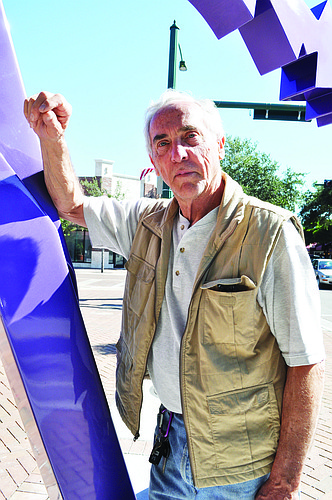- April 18, 2024
-
-
Loading

Loading

Bruce White thought he wanted to be a painter, until his paintings became so heavy and encrusted with metal that he had to use bolts to hang them on the wall.
It wasn’t until a friend at Columbia University jokingly suggested that the artist toss his pieces on the floor and work from the ground up, that White considered the inevitable.
He was a sculptor.
“Eventually,” White says, “I just learned how to weld steel.”
Oddly, this transformation pleased his conservative Protestant father, a New Jersey tool-and-die maker, who had always worried that an art career would make his son “strange.”
“I think he was pleased when I started working with steel,” White says. “He must have thought, ‘OK. He’s working with metal. This guy’s gonna turn out all right.’”
From graduate school on, White began working with his hands. Only in recent years has he begun painting again. A collection of his prints is on display through Christmas at the Longboat Key Club.
“Unfortunately, with sculpture you end up with mostly wealthy clients,” White says. “I figured it would be nice to create something affordable, particularly something my friends could afford.”
Influenced by Japanese minimalism, White loved the way a simple structure could drastically alter the feel of a public space.
He idolized David von Schlegell, an aircraft engineer-turned-sculptor who rose to prominence in the 1960s for creating streamlined abstract sculptures, many of which were commissioned by cities all over the country.
Fueled by the idea of doing a lot with a little, White found himself mimicking the minimalist von Schlegell.
“When you’re starting out, the hardest part is learning how to escape being pulled in the direction of someone you admire,” White says. “The trick is to learn to be yourself, to discover your own uniqueness.
In the beginning, we always copy the people we admire.”
It didn’t take the sculptor long to find his niche. His commissions began popping up in cities such as Chicago, Indianapolis, Houston and Detroit, to name a few. As his commission list grew, so did his work.
Though White, a Nokomis resident, never considered himself a monumental sculptor, his clients frequently requested colossal pieces, as was the case with the 30-foot-tall stainless steel sculpture, “Izar,” commissioned by the Newport News Williamsburg International Airport, in Virginia.
“They wanted something iconic,” he says of the towering airport art. “Something that can be seen without the buildings or surroundings interfering with it or dwarfing it.”
One of his biggest pieces — a 48-by-53-foot-high painted aluminum sculpture that White created for a mall in Oklahoma City — was so large the sculptor couldn’t afford the $1 million it cost to move the work during a mall construction project.
Instead, the piece was scrapped.
“What can you do?” he says. “That’s the problem with working large. When a community changes, you never know what will happen to the art.”
He supplemented his commissions by teaching art at high schools and colleges.
One of his first teaching jobs was at Florida State University, where he met his wife, Gail, a Sarasota native and education major.
For six years, he bounced between teaching positions in New York, New Jersey, and Illinois, eventually settling in at Northern Illinois University, where he remained for 30 years, teaching sculpture to graduate students, many of whom he’s remained close with over the years.
“It’s a rewarding occupation,” he says of teaching, “even if some of my students are now my competition.”
He laughs, but he’s not kidding.
One of his former students crafted the water sculpture at the Five Points roundabout — a prime location for public art.
White points to it while walking in the direction of the 10-foot-tall sculpture he installed Nov. 14, on Main Street in front of Mattison’s City Grille.
Titled “Impulse” and shaped like a purple zigzag, the piece is one of a dozen new sculptures selected as part of the city of Sarasota’s year-long public art competition, “Intersections.”
It’s White’s third sculpture in downtown Sarasota. His “Meander” is located in the courtyard of the Federal Building, and his “Samurai” is located near the downtown bus terminal.
He created “Impulse” on a whim, using scrap wood to build a model while watching TV in his summer home and studio in DeKalb, Ill.
“I was sitting there with this little pile of wood in front of me,” White says. “And the next thing you know, I’m building a sculpture. It’s a lot like watching leaves fall. They don’t fall straight down and plunk on the grass. Each leaf has a destiny because of its shape. I get into the notion of randomness.”
BOX
WHAT’S ‘INTERSECTIONS’?
Twelve artists have been selected by the city of Sarasota to display their sculptures for one year in the five downtown shopping districts.
Contestants include Robin Morgan, Valeria Yamamoto, Beth Nybeck, James Evans, Claudia Jane Klein, Dennis Kowal, Ofra Friedmen, Zoran Mojsilov, Bruce White, Mark Chew, David Gonya and Tekla.
Artists began installing sculptures this fall. The pieces will remain on display for a year.
The winning work will be selected next November by the City Commission, with input from the Public Art Committee and the community, and purchased for $20,000.
Contact Heidi Kurpiela at [email protected].